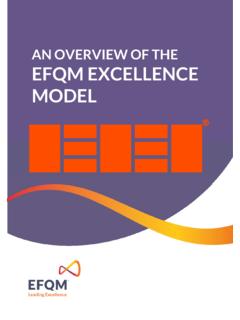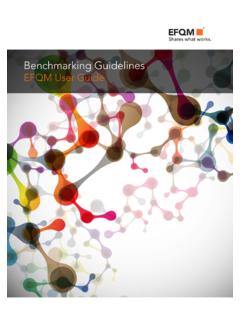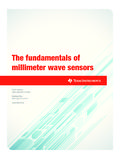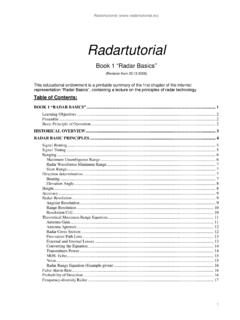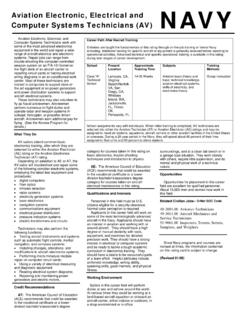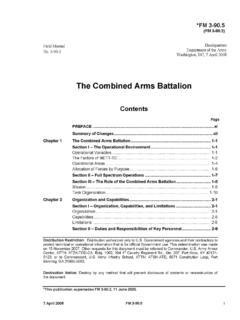Transcription of to convert the Fundamental Concepts and RADAR - …
1 The world does not stand still. It is changing ever more rapidly. The interdependencies between organisations, communities, countries and economies are strengthening and increasing in complexity. To remain competitive in this environment, any organisation needs to continually innovate and improve. Now, more than ever before, an organisation needs to understand, balance and effectively manage the needs and expectations of their stakeholders. The efqm Excellence Model is a framework to understand and manage this complexity. The Model is pragmatic and practical, developed by leading organisations, to stimulate continuous improvement. This document provides an overview; the full version of the Model is available from our webshop. The efqm Excellence Model allows people to understand the cause and effect relationships between what their organisation does and the Results it achieves.
2 The Model comprises of a set of three integrated components: The Fundamental Concepts define the underlying principles that form the foundation for achieving sustainable excellence in any organisation. The Criteria provide a framework to help organisations to convert the Fundamental Concepts and RADAR . thinking into practice. RADAR is a simple but powerful tool for driving systematic improvement in all areas of the organisation. The beauty of the Model is that it can be applied to any organisation, regardless of size, sector or maturity. It is non-prescriptive and it takes into account a number of different Concepts . It provides a common language that enables our members to effectively share their knowledge and experience, both inside and outside their own organisation. 2. The Fundamental Concepts of Excellence outline the foundation for achieving sustainable excellence in any organisation.
3 They can be used as the basis to describe the attributes of an excellent organisational culture. They also serve as a common language for top management. There are 8 Fundamentals Concepts : Excellent organisations consistently add value for customers by understanding, anticipating and fulfilling needs, expectations and opportunities. Excellent organisations have a positive impact on the world around them by enhancing their performance whilst simultaneously advancing the economic, environmental and social conditions within the communities they touch. Excellent organisations enhance their capabilities by effectively managing change within and beyond the organisational boundaries. Excellent organisations generate increased value and levels of performance through continual improvement and systematic innovation by harnessing the creativity of their stakeholders.
4 Excellent organisations have leaders who shape the future and make it happen, acting as role models for its values and ethics. Excellent organisations are widely recognised for their ability to identify and respond effectively and efficiently to opportunities and threats. Excellent organisations value their people and create a culture of empowerment for the achievement of both organisational and personal goals. Excellent organisations achieve sustained outstanding results that meet both the short and long term needs of all their stakeholders, within the context of their operating environment. 3. The efqm Excellence Model allows people to understand the cause and effect relationships between what their organisation does, the Enablers, and the Results it achieves. To achieve sustained success, an organisation needs strong leadership and clear strategic direction.
5 They need to develop and improve their people, partnerships and processes to deliver value-adding products and services to their customers. If the right approaches are effectively implemented, they will achieve the results they, and their stakeholders, expect. There are 5 enablers, pictured on the left-hand side of the Model. These are the things an organisation needs to do to develop and implement their strategy. Definition: Excellent organisations have leaders who shape the future and make it happen, acting as role models for its values and ethics and inspiring trust at all times. They are flexible, enabling the organisation to anticipate and react in a timely manner to ensure the on-going success of the organisation. Definition: Excellent organisations implement their mission and vision by developing and deploying a stakeholder focused strategy.
6 Policies, plans, objectives and processes are developed and deployed to deliver the strategy. Definition: Excellent organisations value their people and create a culture that allows the mutually beneficial achievement of organisational and personal goals. They develop the capabilities of their people and promote fairness and equality. They care for, communicate, reward and recognise, in a way that motivates people, builds commitment and enables them to use their skills and knowledge for the benefit of the organisation. 4. Definition: Excellent organisations plan and manage external partnerships, suppliers and internal resources in order to support strategy and policies and the effective operation of processes. Definition: Excellent organisations design, manage and improve processes to generate increasing value for customers and other stakeholders.
7 There are 4 result areas, shown on the right-hand side of the Model. These are the results an organisation achieves, in line with their strategic goals. In all 4 results areas, we find that excellent organisations: Develop a set of key performance indicators and related outcomes to determine the successful deployment of their strategy, based on the needs and expectations of the relevant stakeholder groups. Set clear targets for key results, based on the needs and expectations of their business stakeholders, in line with their chosen strategy. Segment results to understand the performance of specific areas of the organisation and the experience, needs and expectations of their stakeholders. Demonstrate positive or sustained good business results over at least 3 years. Clearly understand the underlying reasons and drivers of observed trends and the impact these results will have on other performance indicators and related outcomes.
8 Have confidence in their future performance and results based on their understanding of the cause and effect relationships established. Understand how their key results compare to similar organisations and use this data, where relevant, for target setting. Definition: Excellent organisations achieve and sustain outstanding results that meet or exceed the needs and expectations of their customers. Definition: Excellent organisations achieve and sustain outstanding results that meet or exceed the needs and expectations of their people. Definition: Excellent organisations achieve and sustain outstanding results that meet or exceed the needs and expectations of relevant stakeholders within society. Definition: Excellent organisations achieve and sustain outstanding results that meet or exceed the needs and expectations of their business stakeholders.
9 5. The RADAR logic is a dynamic assessment framework and powerful management tool that provides a structured approach to questioning the performance of an organisation. At the highest level RADAR logic states that an organisation should: Determine the Results it is aiming to achieve as part of its strategy. Plan and develop an integrated set of sound Approaches to deliver the required results both now and in the future. Deploy the approaches in a systematic way to ensure implementation. Assess and Refine the deployed approaches based on monitoring and analysis of the results achieved and on-going learning activities. The Model can be used to assess an organisation's current capabilities. The output of an assessment is normally a number of strengths and opportunities to improve future performance. Identifying an organisation's strengths is important, not only so you don't stop doing the things you're good at but also because these strengths may help in addressing the issues identified.
10 By definition, complying with a defined standard is not excellence. Excellence is about going beyond what is expected. Unlike auditing against a standard, an assessment gives the management team a number of opportunities; options. Which points they choose to address, had how they choose to address them, will depend on their strategic priorities. 6. efqm is committed to help organisations drive improvement through the use of the efqm Excellence Model, a comprehensive management framework used by over 30 000 organisations in Europe. For the last 20 years, we manage the development of this Model, incorporating the experiences and learning from these organisations to ensure it reflects reality. To help you implement our Model, we provide training, assessment tools and recognition. But our real talent comes from gathering good practices and integrating those within our portfolio.
